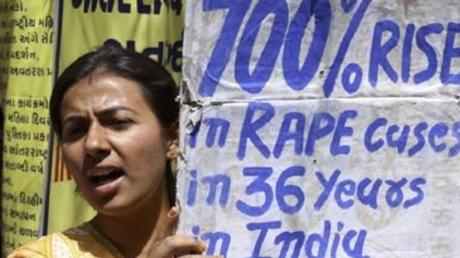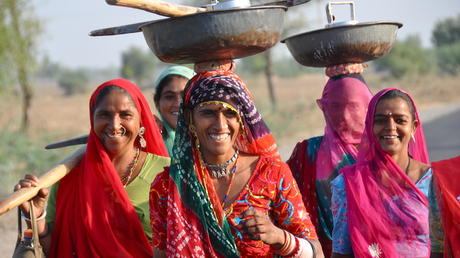The election results were announced on May 16 and as expected the Bhartiya Janta Party (BJP) led National Democratic Alliance have emerged victorious.
The exit polls underestimated the magnitude of the Modi ‘wave’ which swept regional parties away and gave a massive mandate to the BJP alone with 282 seats. In the history of independent India, this is the first non-Congress national political party that has emerged as the single majority party in the lower house of Indian parliament.
A stable government is envisaged and a wide spread consensus exists that the ‘reinvented’ BJP has been given this popular mandate for development and growth, to propel India towards its full potential as a regional power and a major global player. In this piece I reflect on how women fared in these momentous elections and what lies ahead with this new government.
Narendra Modi has dedicated his new government to youth, poor and women and it will be great to see what special measures are taken than this just being empty rhetoric.
Poor
In the aftermath of the election results the media highlighted the fact that although fewer Muslims were elected this time (and some prominent BJP leaders like Shahnawaz Hussain losing from Bihar) women had done remarkably well. One had to look at the numbers to conclude that the increase in women MP’s was only marginal.
The 16th Lok Sabha has two more elected women MP’s than the last time. The 543-member house had 59 elected women last time, which has gone up to 61 in these elections. I am not sure that this is reason enough to celebrate. Only 11 per cent of our elected representatives come from half of the population, which is lower than the parliament in Pakistan, Afghanistan, and Sri Lanka etc.
...Women had a better winning percentage than men, 9.13 to 6.36. In fact, looking at data from 1957 till 2014, women have always outperformed men...
Far more worrying was the trend that parties did not make the conscious effort of putting women candidates in the fray. According to data released by the Election Commission out of a total of 8,251 candidates, only 668 were women. Ironically women had a better winning percentage than men, 9.13 vis a vis 6.36. In fact if one looks at data from 1957 till 2014, women have always outperformed men, with the winning percentage being the best in 1984.
Increasingly parties will have to democratise and include more women. The fact that only 11% women were elected as members in Indian Parliament, is in direct contrast to the fact that women voters outnumbered men in 16 out of 28 states and 7 Union Territories. This does not look good for a country aspiring to be a regional and global player, a country where gender norms are entrenched and gender relations are based on violence and hierarchy.
Fair
There is palpable anxiety in certain sections of Indian population about the future course of action of the new government and its leader. The PM elect, Narendra Modi has dedicated his new government to youth, poor and women and it will be great to see what special measures are taken than this just being an empty rhetoric. As someone who supports the Uniform Civil Code it is my hope that it will be guaranteed through the gender lens and not devised to punish minority communities.
The Hindu laws also require some fundamental changes to reflect the changed norms of the current era. The BJP manifesto also promises greater security and employment opportunities for women. At this point one can only hope that the price of that ‘security’ will not be personal freedom and moral policing as is widely feared with the BJP’s allegiance to the conservative and reactionary ideology of the RSS.
However some of the positives should not be lost in the ensuing din of electoral victory and defeat.
Good
The masculinist bravado of the election campaign is paving way for serious policy and structural changes which is widely anticipated as a welcome change from the lethargy of the previous government. An important aspect of these elections has been the emergence of simple people winning this election at the expense of some well-connected and privileged class elites. These elections have successfully debunked the notion of protection for political dynasties and privileged families. In many ways, these elections are the story of the rise of the aam aadmi and aurat (common men and women), a script prepared by Aam Aadmi Party (AAP)’s Arvind Kejriwal, but played to perfection by Narendra Modi and his cohorts. It is the democratic strength of India that has catapulted a low class/caste person who had never been to the Parliament House in Delhi to the highest executive position in the country.
Having more women in positions of power and authority does not mean that gender equality is achieved.
One man’s gain is also another woman’s gain as Anandiben Patel becomes the first woman Chief Minister of the state of Gujarat as Modi moves to Delhi. A dedicated BJP worker and known for her organisational work, Anandiben Patel was born on 21st November, 1941 in Mehsana district of Gujarat in a family of farmers. She will now run the state after being in the state cabinet for 4 consecutive terms. She went to a school, where she was a single girl among 700 boys until 4th grade. Even during her undergraduate days she was the only girl during her Bachelor’s of Science degree in entire college.
Quiet and unassuming, Anandiben has transcended all barriers to rise up in the state politics. Her appointment also looks good for PM elect Narendra Modi who is a conservative hardliner addressing women mostly as ‘mothers and sisters’. Although the union cabinet is still to be declared, Sushma Swaraj and Smriti Irani are two women frontrunners to important ministries. There is also good news that Kiran Bedi, India’s most well known and respected police officers, is all set to make a political debut from the BJP in the Assembly polls in Delhi.
Assessment
Having more women in positions of power and authority does not mean that gender equality is achieved. Neither does it imply that women do a better job than men. It simply means that the polity is sufficiently democratised and also debunks the myth that gender division of work has an inherent merit, or that keeping women out of ‘power’ serves any purpose other than to retain patriarchal control. We have seen women PM, Chief Ministers, Governors and even a President but the ground reality is that India remains one of the most patriarchal societies in the world where violence against women is the norm and women woefully underrepresented in the highest elected body.
The patriarchal mindset does not change because we have more women at the helm of affairs, many of whom have demonstrated similar qualities of authoritarianism and hawkishness we have seen in males. However, democracy means equal participation and a stake in one’s future, autonomy to make one’s choices. The current political system of India has a severe gender problem where women are disadvantaged and a masculinist polity extensively decides many aspects of women’s lives.
Narendra Modi and the BJP say achhe din aane wale hain (good days are coming). One would hope we get to see the good days when gender equality and ending violence against women becomes a political priority and not just an empty moral yardstick consigned to civil society groups and women’s activists. We are waiting and watching.
Thumbnail image provided via WikiCommons. Source: http://commons.wikimedia.org/wiki/File:Smiles_and_determination_of_rural_Indian_women.jpeg




